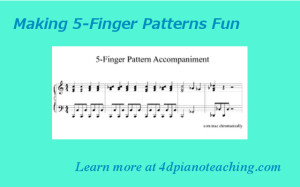
I strongly believe in the value of learning 5-finger patterns in the early stages of piano study. Being comfortable playing in 5-finger positions greatly helps with learning new repertoire and also sets a foundation for learning many theory concepts. The biggest challenge is making 5-finger patterns an interesting activity instead of the drudgery that scales and technique can often become. I’ve found that adding a fun accompaniment can go great lengths in motivating students to solidly learn 5-finger patterns. The accompaniment I use is not original to me, it comes originally from James Lyke’s book Keyboard Musicianship and was introduced to me by Dr. Ann Gipson at TCU. It is a basic chord progression:
I IV V6/5 IV I
with a tonic pedal point in the LH. Here is a notation of the accompaniment:
Once you get the pattern down, it is pretty easy to move up by half steps until you return to C. The big challenge for your students is to be able to move through the 5-finger patterns chromatically, keeping a steady beat, with only 2 beats in between each. I find that once we try this together, it becomes a motivating challenge that students want to try again the next week until they can do it.
Author: Spring
Spring Seals, NCTM, teaches 60 piano students ranging from age 3 to 70 in Fort Worth, Texas. She also serves as the Director of Certification for TMTA. She is passionate about helping teachers become more effective in their studios through professional development, new resources, and fresh ideas.

